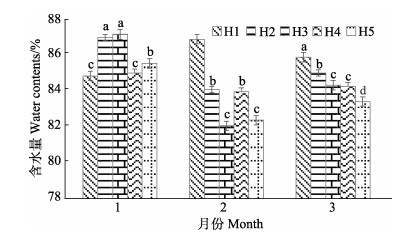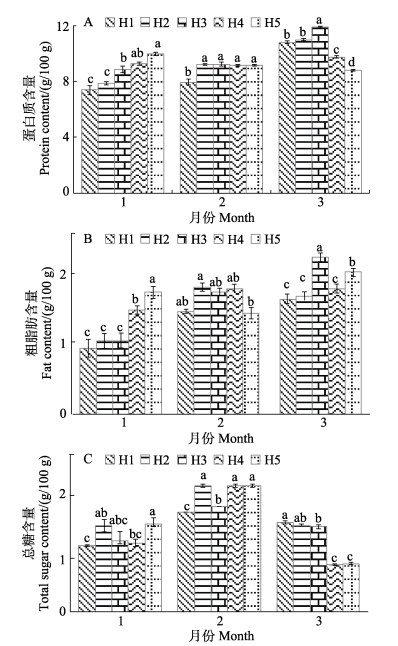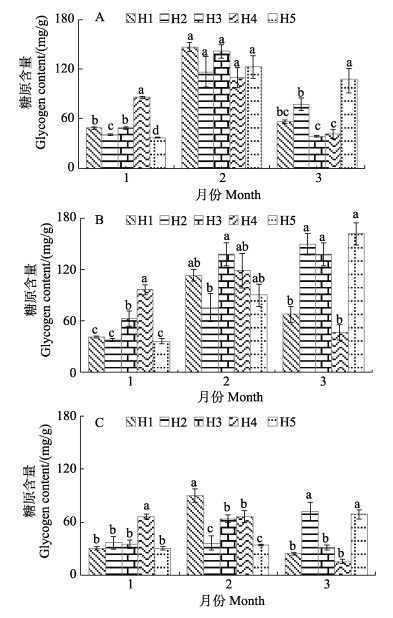2. 中国水产科学研究院黄海水产研究所 山东 青岛 266071;
3. 青岛海洋科学与技术试点国家实验室海洋生态与环境科学功能实验室 山东 青岛 266237;
4. 獐子岛集团股份有限公司 辽宁 大连 116001
2. Yellow Sea Fisheries Research Institute, Chinese Academy of Fishery Sciences, Qingdao 266071, China;
3. Marine Ecology and Environmental Science Laboratory, Pilot National Laboratory for Marine Science and Technology (Qingdao), Qingdao 266237, China;
4. Zoneco Group Co, Ltd, Dalian 116001, China
贻贝又名壳菜,在我国北方俗称海虹,南方称淡菜(毛玉英等, 1993),是一种营足丝附着生活的双壳类软体动物,有“东方夫人”和“海上鸡蛋”的美誉。2020年,我国贻贝养殖面积为4.4万hm2,养殖产量超过88万t,是仅次于牡蛎、蛤、扇贝的第四大养殖贝类(农业农村部渔业渔政管理局等, 2021)。紫贻贝(Mytilus galloprovincialis)是高蛋白、低脂肪(励炯, 2007)且具有较高的药用和食疗价值的养殖贝类,主要以硅藻和小型浮游生物等为食(孟庆良, 2005),适应力强、养殖技术简单成熟、产量高,是我国最重要的贻贝养殖品种之一。
海州湾位于山东省与江苏省交界沿岸,属开放型海湾,是我国典型的紫贻贝养殖区,年产量超过15万t,年产值可达3亿元。而随着养殖规模扩大,近岸养殖密度增加,同时,由于陆源污染物的输入,导致病害增加、养殖效益降低,为了追求更高的效益,海水养殖逐渐向离岸区发展。张福绥等(1999)提出了将养殖区域扩展到外海海域的“外延稀养”策略,离岸养殖成为发展趋势(刘福利等, 2019)。近年来,得益于养殖技术的进步,海州湾离岸海域已出现紫贻贝养殖,养殖区水环境的不同可能会导致贝类个体生化成分的差异(丁丹勇等, 2018),但有关近岸和离岸养殖区紫贻贝的生长和营养物质差异尚未见报道。海州湾紫贻贝的春季繁殖期较长,关于双壳贝类繁殖期内生化成分的变化已有相关研究。Li等(2006)研究了褶牡蛎(Crassostrea plicatula)的繁殖周期和生化组成及其与环境因子的关系。程亮等(2013)分析了厚壳贻贝(Mytilus scoruscus)不同性腺发育时期内的生化成分变化。而关于紫贻贝在繁殖期的营养物质变化及其与环境因子的关系鲜有报道。本研究分析了近岸和离岸养殖区春季繁殖期紫贻贝营养成分的时空变化特征及其影响因素,并探究了紫贻贝离岸养殖的优势,为拓展紫贻贝养殖空间、提升产品品质,确定最佳的收获时间和优化养殖空间布局提供数据参考。
1 材料与方法 1.1 样品采集2021年1—3月(每个月采集1次)在海州湾不同离岸距离养殖区采集紫贻贝样品和水样。根据养殖区离岸距离设置5个站位(图 1),分别为H1 (离岸1 n mile)、H2 (离岸3 n mile)、H3 (离岸7 n mile)、H4 (离岸13 n mile)和H5 (离岸21 n mile);H3、H4和H5站位距岸较远且水深在10 m以上,属于离岸养殖区(李大海等, 2019; 刘福利等, 2019)。每个站位采集紫贻贝样品300个,并用采水器取2 500 mL水样(2 m深),同时设置3个平行组(取自不同的筏架,每个筏架采集100个样品)。使用YSI (ProODO)现场测定水温、盐度和溶解氧。分别采用分光光度计法和重量法测定叶绿素a (Chl-a)浓度、悬浮颗粒物(SPM)和颗粒有机物(POM)含量,测定方法详见《海洋调查规范》(GB12763-2007)。

|
图 1 采样站位设置 Fig.1 Setting of sampling stations |
样品放入加冰泡沫箱运回实验室,每组随机取30个样品用于生物学参数测定。用吸水纸吸去样品壳表面的水分,使用精密分析天平(精确到0.000 1 g)测量带壳湿重(g)后解剖取出软组织,测量软组织湿重(g),用电热鼓风干燥箱(DHG-9240A)在70℃烘干至恒重,称量软组织干重(g)和壳干重(g),计算条件指数和含水量(Camacho et al, 1995),
| $ 条件指数(\%)=(软组织干重/壳干重)×100\% $ | (1) |
| $\begin{array}{l} 含水量(\%)=(软组织湿重–软组织干重)/\\ \;\;\;\;\;\;\;\;\;\;\;\;\;\;\;\;\;\;\;软组织湿重×100\% \end{array} $ | (2) |
取紫贻贝样品的外套膜、斧足和性腺,冷冻干燥48 h后采用微量蒽酮法测定糖原含量(陈夕等, 2021; Ojea et al, 2004; Mcfarland et al, 2016);烘干后的软组织研磨后用于其他成分测定,蛋白质采用凯氏定氮法(GB 5009.5-2016)进行测定;脂肪采用酸水解法(GB/T5009.6-2003)测定;总糖(以葡萄糖计)参照酸水解-莱茵–埃农氏法(GB 5009.8-2016)测定、氨基酸按酸水解法(GB/T5009.124-2016)测定。
1.3 数据处理研究数据采用Excel 2019和R 4.0.5软件进行统计分析,比较各站位环境指标、紫贻贝的条件指数、含水量、营养成分、氨基酸组成和糖原含量的差异,以P < 0.05作为差异显著水平进行单因素方差分析(one-way ANOVA)。
2 结果 2.1 养殖区理化因子特征养殖区各站位的环境参数见表 1。3个月各站位的水温、盐度、溶解氧含量、Chl-a浓度、SPM和POM含量存在显著性差异(P < 0.05),H5站位的盐度、溶解氧、Chl-a浓度和POM含量显著高于其他站位(P < 0.05),且随着离岸距离增加,水温、Chl-a浓度和溶解氧含量也有增高的趋势。
|
|
表 1 2021年1—3月站位水环境参数 Tab.1 Environmental data of each station from January to March in 2021 |
H2~H5站位紫贻贝的条件指数在1—3月呈先上升后下降的趋势,且均于2月达到最大值,H4站位紫贻贝的条件指数显著高于其他站位(P < 0.05);H1站位紫贻贝的条件指数在1—3月呈逐渐上升趋势,在3月达到最大值(图 2)。H2~H5站位紫贻贝的含水量在1—3月呈先下降后上升的趋势,除H1站位外,其他站位紫贻贝含水量的变化规律与条件指数相反(图 3)。

|
图 2 1—3月不同站位紫贻贝条件指数的变化 Fig.2 Changes of CI of M. galloprovincialis at different stations from January to March 不同小写字母表示同一月份不同站位间差异显著(P < 0.05),下同。 Different lowercase letters indicate significant difference among stations within the same month (P < 0.05), the same as blow. |

|
图 3 1—3月不同站位紫贻贝含水量的变化 Fig.3 Changes of water contents in soft tissue of M. galloprovincialis at different stations from January to March |
海州湾紫贻贝主要营养成分与月份和站位相关联。H1~H3站位的紫贻贝的蛋白质含量在1—3月呈逐渐上升的趋势,而H4站位紫贻贝的蛋白质含量在2月稍有下降,H5站位紫贻贝的蛋白质含量在1—3月呈逐渐下降的趋势(图 4A)。H1、H3、H4站位的紫贻贝的脂肪含量在1—3月逐渐上升,而H2站位的紫贻贝脂肪含量在2月达到最大值,H5站位在2月出现最小值(图 4B)。所有站位紫贻贝的总糖含量在1—3月均呈先上升后下降的趋势,且H4和H5站位紫贻贝的总糖含量在2—3月显著下降,并在3月显著低于其他站位(P < 0.05) (图 4C)。

|
图 4 1—3月不同站位紫贻贝营养物质含量变化 Fig.4 Changes of nutrient contents in M. galloprovincialis at different stations from January to March |
如表 2所示,在1月和2月,H5站位紫贻贝的16种氨基酸总量和呈味氨基酸总量均显著高于其他站位(P < 0.05);在3月,H1站位紫贻贝的16种氨基酸总量最高,H3站位紫贻贝的呈味氨基酸总量出现最大值。1—3月H5站位紫贻贝的2个指标均呈下降趋势。
|
|
表 2 1—3月各站位紫贻贝的氨基酸组成 Tab.2 Amino acid compositions of M. galloprovincialis at different stations from January to March |
1—3月紫贻贝外套膜、斧足和性腺的糖原含量的变化情况见图 5。结果显示,所有站位紫贻贝外套膜中的糖原含量在2月达到峰值,而3月H5站位紫贻贝外套膜的糖原含量显著高于其他站位(P < 0.05)。1—3月,H1、H4站位紫贻贝斧足和性腺的糖原含量呈先上升后下降趋势,而H2、H5站位紫贻贝斧足和性腺的糖原含量持续上升,H3站位的紫贻贝斧足的糖原含量在1—2月上升,并在2—3月保持稳定,而性腺的糖原含量在1—3月呈先上升后下降的趋势。

|
图 5 1—3月份紫贻贝不同部位糖原含量变化 Fig.5 Changes of glycogen content in different parts of M. galloprovincialis from January to March A:外套膜;B:斧足;C性腺 A: Mantle; B: Foot; C: Gonad |
研究表明,水温、食物密度和洋流特征等可以通过影响贝类的食物可获得性和生理代谢速率来影响贝类的生长、发育和繁殖(Dridi et al, 2007; Ojea et al, 2004; Ruiz et al, 1992),在贝类的生活史周期内,条件指数通常在性成熟过程中逐渐升高,且随着配子排放而逐渐下降(Kim et al, 2005)。在本研究中,H1站位紫贻贝的条件指数在1—3月一直呈现逐步上升的趋势,可判断其在2月尚处于生长期,在3月或者更晚的时间进入成熟期;而其他站位紫贻贝的条件指数在2月到达成熟期后达到峰值,此后,在3月随着部分紫贻贝进入排放期而逐渐减小(张福绥等, 1980; 程亮等, 2013),这可能是由于近岸水域的水温和Chl-a浓度较低,导致性腺发育所需积温和能量储备不足。贝类软体部的含水量与繁殖周期的肥满度变化密切相关。厚壳贻贝在生长期到成熟期的过程中,随着营养物质的快速积累,组织间隙逐渐被实质性营养物质所填充,软体部的含水量降至最低;进入排放期后因配子的大量排放,组织中的含水量又显著回升(程亮等, 2013),这与本研究的分析结果一致。从条件指数和含水量的变化来看,除近岸H1站位之外的其他站位的紫贻贝在3月都已经进入了配子排放期。
许多贝类的脂肪含量的季节性变化与糖原含量的变化趋势相反,表明糖原可能转化成脂肪,为卵黄的形成提供物质和能量(Robert et al, 1993)。本研究中,在1—3月,各站位紫贻贝呈脂肪含量逐渐增加的趋势,而外套膜和性腺的糖原含量呈下降的趋势,这与其他学者的研究结果一致(程亮等, 2013; 张永普等, 2004)。紫贻贝体内生化成分的变化与配子的合成和释放密切相关(Li et al, 2006),其在产卵季节会消耗体内储存的糖原(Gabbott et al, 1973)。糖原是动物配子发生的主要能量储备,生殖周期中,糖原含量的变化反映了为配子发生提供所需能量的策略,即保守策略和机会主义(Shi et al, 2019)。紫贻贝在生殖过程中很明显利用了体内储存的糖原提供能量。贝类的性腺发育与温度和浮游植物量密切相关(林志华等, 2004),本研究中的H5站位的紫贻贝发育较快,可能是因为离岸养殖区的平均水温高于近岸养殖区,使得离岸养殖区的紫贻贝在繁殖期内积累的有效积温更高,且Chl-a浓度和POM含量要高于近岸站位,紫贻贝的代谢更快,有助于营养物质的积累,而营养物质的积累决定了生殖腺的发育(Gabbott et al, 1973)。
3.2 紫贻贝离岸养殖发展潜力相比于近岸区域,本研究中离岸养殖区的紫贻贝具备更快的蛋白质和脂肪积累能力,此外,紫贻贝会将糖转化成能量形式更高的脂肪和蛋白质贮存起来,以满足精卵细胞的发育需求(Napolitano et al, 1992)。研究表明,厚壳贻贝个体的总糖含量从增殖期开始逐渐下降,并在成熟期达到最低值(程亮等, 2013)。本研究中,各站位紫贻贝的总糖含量在2—3月明显下降,且在H4和H5站位下降最明显,由此初步判断,各站位紫贻贝在3月均已进入成熟期,H4和H5站位紫贻贝更快完成能量储存。
动物蛋白的鲜美程度主要取决于蛋白质中的呈味氨基酸的总量(施永海等, 2020)。本研究中,离岸站位H5的紫贻贝个体的呈味氨基酸总量在1月和2月高于其他站位,离岸站位H3的紫贻贝在3月高于其他站位,且该站位的紫贻贝的蛋白质、脂肪和总糖含量较高,所以,综合2个站位紫贻贝呈味氨基酸总量和其他营养成分来看,H3站位的紫贻贝适宜在3月收获,H5站位的紫贻贝适宜在2月收获,离岸养殖的紫贻贝在2月即可上市,比近岸区域早接近1个月。离岸养殖紫贻贝提早上市可以延长贻贝上市供应时间,降低集中上市导致的竞争压力,另外,离岸养殖紫贻贝的养殖周期短、养殖空间大、口感好,具有较好的市场潜力。近年来,得益于互联网技术的发展,网络销售已经成为各行业的重要销售渠道,这种方式可以避开第三方直接销售给顾客,商品单价更高,市场巨大;结合离岸养殖紫贻贝的优势,养殖户可以利用网络销售实现再度增收。
近海区域的环境问题是阻碍紫贻贝产业良性发展和增产提效的主要客观因素(程海等, 2019; 唐启升等, 2013),而与近岸海域相比,离岸海域空间大、水体交换频繁、营养盐充足、饵料密度高、陆源污染物风险低(李大海等, 2019),具有较好的养殖优势。近年来,新英格兰地区为提高贻贝水产养殖产量开始将养殖区转移到离岸海域(Fairbanks et al, 2016),虽然离岸养殖需要的成本和技术更高,但离岸养殖的综合效益还是很可观的(刘福利等, 2019),发展离岸养殖有利于优化海洋开发的空间结构,提高食物生产的整体效率,缓解食物生产的资源环境压力,培育形成新的海洋技术优势和产业优势(李大海等, 2019)。
本研究通过对不同离岸距离养殖区紫贻贝在1—3月的条件指数、营养成分、氨基酸和水环境理化因子的变化发现,离岸养殖区紫贻贝的营养成分和氨基酸在2月含量丰富,而近岸养殖区紫贻贝营养成分积累缓慢,这种营养物质储备的差异主要与水温和饵料密度有关,离岸养殖区更有利于紫贻贝营养物质积累及生长。
Bureau of Fisheries, Ministry of Agriculture and Rural Affairs, National Fisheries Technology Extension Center, China Society of Fisheries. China fishery statistical yearbook 2021. Beijing: China Agriculture Press, 2021 [农业农村部渔业渔政管理局, 全国水产技术推广总站, 中国水产学会. 2021中国渔业统计年鉴. 北京: 中国农业出版社, 2021]
|
CAMACHO A P, LABARTA U, BEIRAS R. Growth of mussels (Mytilus edulis galloprovincialis) on cultivation rafts: Influence of seed source, cultivation site and phytoplankton availability. Aquaculture, 1995, 138(1/2/3/4): 349-362 |
CHEN X, WU B, WANG Y, et al. Establishment and optimization of micro-reaction system for determination of oyster glycogen content. South China Fisheries Science, 2021, 17(4): 126-132 [陈夕, 吴彪, 王岩, 等. 测定牡蛎糖原含量的微量反应体系的建立与优化. 南方水产科学, 2021, 17(4): 126-132] |
CHENG H, YUAN Y F, LI D R. A review of mussel culture and processing. Rural Economy and Science-Technology, 2019, 30(17): 81-85 [程海, 袁跃峰, 李德然. 贻贝养殖及加工综述. 农村经济与科技, 2019, 30(17): 81-85] |
CHENG L, XU S L, LIU F, et al. Study on the meat condition index and biochemical compositions of Mytilus coruscus in different gonad development stages. Journal of Marine Sciences, 2013, 31(4): 68-73 [程亮, 徐善良, 刘飞, 等. 厚壳贻贝性腺不同发育时期肥满度与生化成分分析. 海洋学研究, 2013, 31(4): 68-73] |
DING D Y, LI C L, HUANG X H, et al. Analysis and evaluation of nutritive components of Crassostrea hongkongensis from different cultural areas. Journal of Anhui Agricultural Sciences, 2018, 46(5): 91-95 [丁丹勇, 李长玲, 黄翔鹄, 等. 不同养殖区香港牡蛎营养成分的分析与评价. 安徽农业科学, 2018, 46(5): 91-95 DOI:10.13989/j.cnki.0517-6611.2018.05.027] |
DRIDI S, ROMDHANE M S, ELCAFSI M. Seasonal variation in weight and biochemical composition of the Pacific oyster, Crassostrea gigas in relation to the gametogenic cycle and environmental conditions of the Bizert lagoon, Tunisia. Aquaculture, 2007, 263(1/2/3/4): 238-248 |
FAIRBANKS L. Moving mussels offshore? Perceptions of offshore aquaculture policy and expansion in New England. Ocean and Coastal Management, 2016, 130(1): 1-12 |
GABBOTT P A, BAYNE B L. Biochemical effects of temperature and nutritive stress on Mytilus Edulis L. Journal of the Marine Biological Association of the United Kingdom, 1973, 53(2): 269-286 DOI:10.1017/S0025315400022268 |
KIM S K, ROSENTHAL H, CLEMMESEN C. Various methods to determine the gonadal development and spawning season of the purplish Washington clam, Saxidomus purpuratus (Sowerby). Journal of Applied Ichthyology, 2005, 21(2): 101-106 DOI:10.1111/j.1439-0426.2004.00636.x |
LI D H, HAN L M, YAN J L. Offshore mariculture: A new space for the growth of marine food. Rural Economy, 2019(9): 140-144 [李大海, 韩立民, 闫金玲. 离岸海水养殖: 海洋食物增长的新空间. 农村经济, 2019(9): 140-144] |
LI J. Seasonal variation in the chemical compositions of Mytilus crassitesta Lischlk and the study of its mechanism of anti-inflammatory effect. Master´s Thesis of Zhejiang University, 2007, 114 [励炯. 厚壳贻贝的营养指标评价及其抗炎机理探究. 浙江大学硕士研究生学位论文, 2007, 114]
|
LI Q, LIU W G, SHIRASU K. Reproductive cycle and biochemical composition of the Zhe oyster Crassostrea plicatula Gmelin in an eastern coastal bay of China. Aquaculture Aquaculture, 2006, 261(2): 752-759 |
LIN Z H, SHAN L Z, CHAI X L, et al. Study on the gonad development and reproductive cycle of Meretrix meretrix Linnaeus. Journal of Fisheries of China, 2004, 28(5): 510-514 [林志华, 单乐州, 柴雪良, 等. 文蛤的性腺发育和生殖周期. 水产学报, 2004, 28(5): 510-514] |
LIU F L, LIANG Z R, ZHANG P Y, et al. Preliminary discussion on the development of Saccharina japonica offshore aquaculture in China. Progress in Fisheries Sciences, 2019, 40(1): 161-166 [刘福利, 梁洲瑞, 张朋艳, 等. 中国海带养殖向离岸深水区发展的初步探讨. 渔业科学进展, 2019, 40(1): 161-166] |
MAO Y Y, CHEN Y X, FENG Z Z. Analysis of nutrtive composition in Mytilus edulis. Journal of Shanghai Fisheries University, 1993, 2(4): 220-223 [毛玉英, 陈玉新, 冯志哲. 紫贻贝营养成份分析. 上海水产大学学报, 1993, 2(4): 220-223] |
MCFARLAND K, SOUDANT P, JEAN F, et al. Reproductive strategy of the invasive green mussel may result in increased competition with native fauna in the southeastern United States. Aquatic Invasions, 2016, 11(4): 411-423 |
MENG Q L. Mussel culture and processing technology. Shandong Fisheries, 2005, 22(9): 6 [孟庆良. 贻贝养殖与加工技术. 齐鲁渔业, 2005, 22(9): 6] |
NAPOLITANO G E, MACDONALD B A, THOMPSON R J. Lipid composition of eggs and adductor muscle in giant scallops (Placopecten magellanicus) from different habitats. Marine Biology, 1992, 113(1): 71-76 |
OJEA J, PAZOS A J, MARTÍNEZ D. Seasonal variation in weight and biochemical composition of the tissues of Ruditapes decussatus in relation to the gametogenic cycle. Aquaculture, 2004, 238(1/2/3/4): 451-468 |
ROBERT R, TRUT G, LABORDE J L. Growth, reproduction and gross biochemical composition of the Manila clam Ruditapes philippinarum in the Bay of Arcachon, France. Marine Biology, 1993, 116: 291-299 |
RUIZ C, ABAD M, SEDANO F. Influence of seasonal environmental changes on the gamete production and biochemical composition of Crassostrea gigas (Thunberg) in suspended culture in El Grove, Galicia, Spain. Journal of Experimental Marine Biology and Ecology, 1992, 155(2): 249-262 |
SHI B, WU Y, ZHOU L. Influence of gonadal development on metal accumulation in the Portuguese oyster, Crassostrea angulata, in subtropical areas. Aquaculture Research, 2019, 50(4): 1142-1152 |
SHI Y H, XU J B, XIE Y D, et al. Nutritional composition analysis and evaluation of eggs in American shad Alosa sapidissima. Fisheries Science, 2020, 39(3): 407-413 [施永海, 徐嘉波, 谢永德, 等. 美洲鲥鱼卵营养成分分析及评价. 水产科学, 2020, 39(3): 407-413] |
TANG Q S, FANG J G, ZHANG J H, et al. Impacts of multiple stressors on coastal ocean ecosystems and integrated multi-trophic aquaculture. Progress in Fishery Sciences, 2013, 34(1): 1-11 [唐启升, 方建光, 张继红, 等. 多重压力胁迫下近海生态系统与多营养层次综合养殖. 渔业科学进展, 2013, 34(1): 1-11] |
ZHANG F S, HE Y C, LIU X S, et al. The breeding seasons of mussels (Mytilus edulis L.) in Jiaozhou Bay, Shandong Province, China. Oceanologia et Limnologia Sinica, 1980, 11(4): 341-350 [张福绥, 何义朝, 刘祥生, 等. 胶州湾贻贝的繁殖期. 海洋与湖沼, 1980, 11(4): 341-350] |
ZHANG F S, YANG H S. Strategic and counter measures to resolve mass mortality problems of Chlamys farreri. Marine Sciences, 1999(2): 38-42 [张福绥, 杨红生. 栉孔扇贝大规模死亡问题的对策与应急措施. 海洋科学, 1999(2): 38-42] |
ZHANG Y P, YING X P, JIA S J. Yearlong changes of the meat condition index, water contents, and biochemical compositions of blood clam (Tegillarca granosa). Henan Science, 2004, 22(1): 57-59 [张永普, 应雪萍, 贾守菊. 泥蚶肥满度、含水量和生化成分的周年变化. 河南科学, 2004, 22(1): 57-59] |



